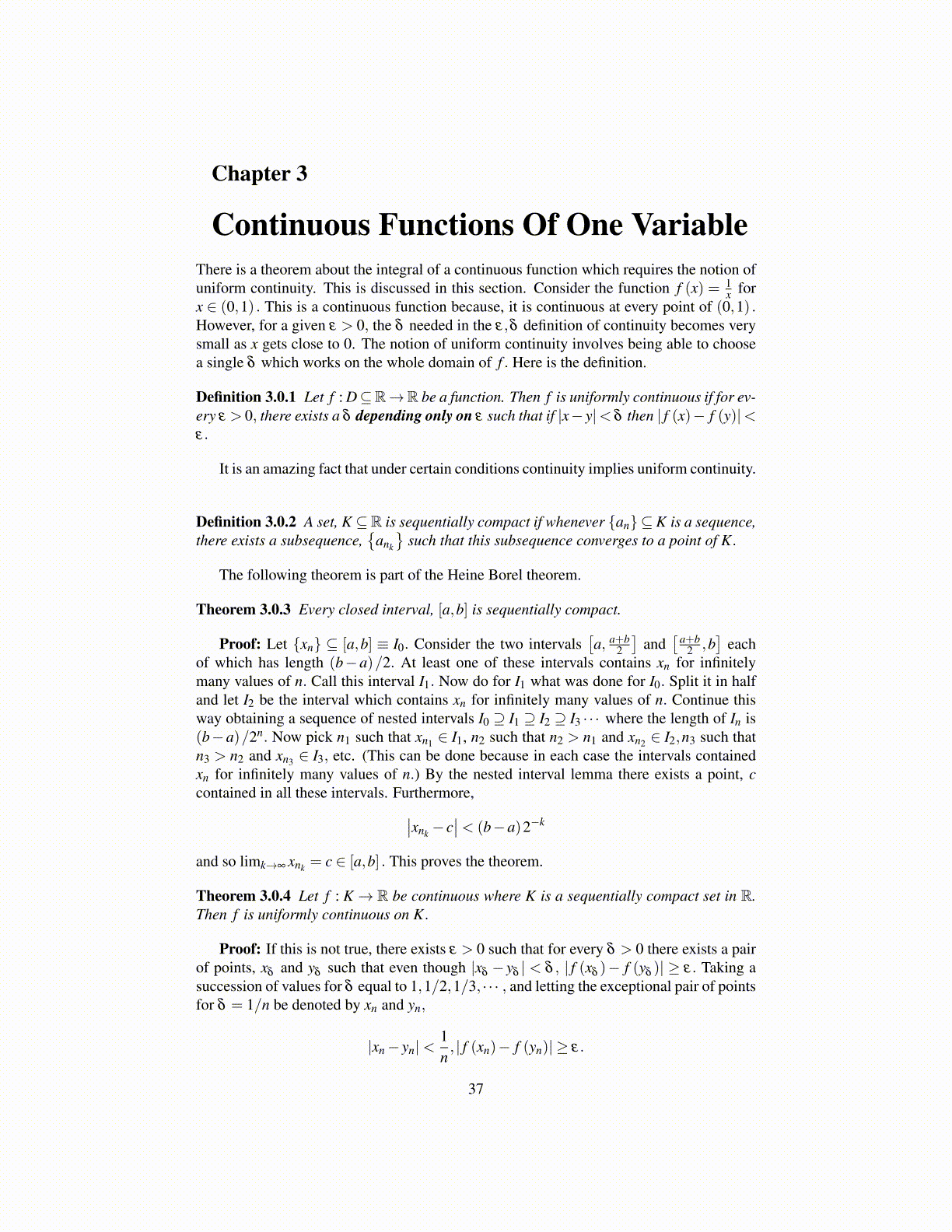
Chapter 3
Continuous Functions Of One VariableThere is a theorem about the integral of a continuous function which requires the notion ofuniform continuity. This is discussed in this section. Consider the function f (x) = 1
x forx ∈ (0,1) . This is a continuous function because, it is continuous at every point of (0,1) .However, for a given ε > 0, the δ needed in the ε,δ definition of continuity becomes verysmall as x gets close to 0. The notion of uniform continuity involves being able to choosea single δ which works on the whole domain of f . Here is the definition.
Definition 3.0.1 Let f : D⊆R→R be a function. Then f is uniformly continuous if for ev-ery ε > 0, there exists a δ depending only on ε such that if |x− y|< δ then | f (x)− f (y)|<ε.
It is an amazing fact that under certain conditions continuity implies uniform continuity.
Definition 3.0.2 A set, K ⊆R is sequentially compact if whenever {an} ⊆K is a sequence,there exists a subsequence,
{ank
}such that this subsequence converges to a point of K.
The following theorem is part of the Heine Borel theorem.
Theorem 3.0.3 Every closed interval, [a,b] is sequentially compact.
Proof: Let {xn} ⊆ [a,b] ≡ I0. Consider the two intervals[a, a+b
2
]and
[ a+b2 ,b
]each
of which has length (b−a)/2. At least one of these intervals contains xn for infinitelymany values of n. Call this interval I1. Now do for I1 what was done for I0. Split it in halfand let I2 be the interval which contains xn for infinitely many values of n. Continue thisway obtaining a sequence of nested intervals I0 ⊇ I1 ⊇ I2 ⊇ I3 · · · where the length of In is(b−a)/2n. Now pick n1 such that xn1 ∈ I1, n2 such that n2 > n1 and xn2 ∈ I2,n3 such thatn3 > n2 and xn3 ∈ I3, etc. (This can be done because in each case the intervals containedxn for infinitely many values of n.) By the nested interval lemma there exists a point, ccontained in all these intervals. Furthermore,∣∣xnk − c
∣∣< (b−a)2−k
and so limk→∞ xnk = c ∈ [a,b] . This proves the theorem.
Theorem 3.0.4 Let f : K→ R be continuous where K is a sequentially compact set in R.Then f is uniformly continuous on K.
Proof: If this is not true, there exists ε > 0 such that for every δ > 0 there exists a pairof points, xδ and yδ such that even though |xδ − yδ | < δ , | f (xδ )− f (yδ )| ≥ ε. Taking asuccession of values for δ equal to 1,1/2,1/3, · · · , and letting the exceptional pair of pointsfor δ = 1/n be denoted by xn and yn,
|xn− yn|<1n, | f (xn)− f (yn)| ≥ ε.
37